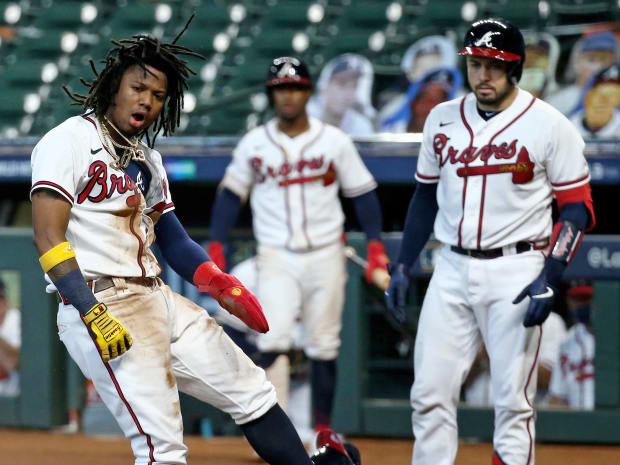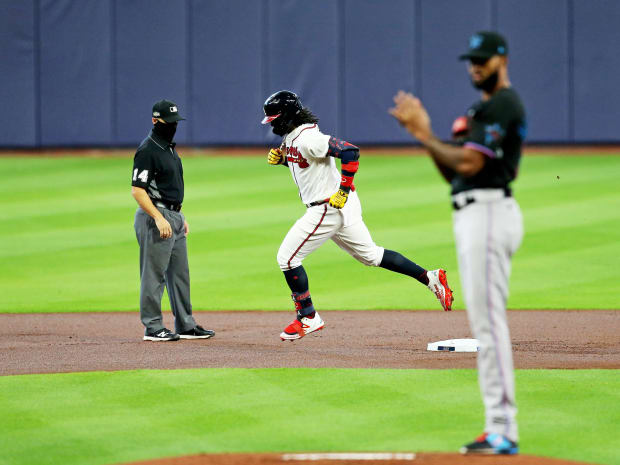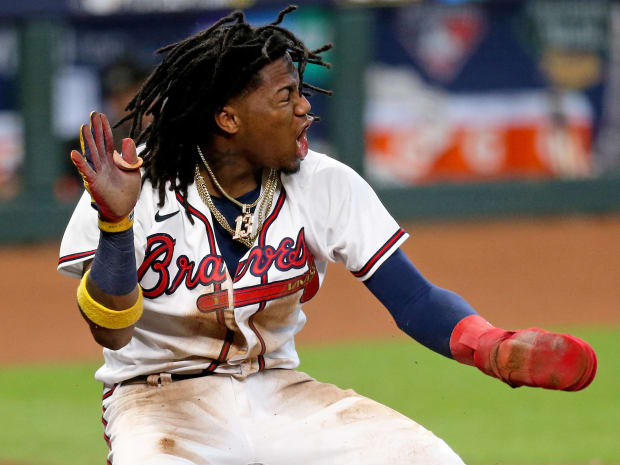Once down three, the Braves scored eight unanswered runs to beat the Marlins, 9–5, in Game 1 of the NLDS.
HOUSTON – If you thought the batter’s box during an Atlanta Braves game is a busy place, you should know their dugout is an apiary. Players constantly buzz about in clusters, all in usually successful attempts to break the code of the opposing pitcher, if not the pitcher himself.
“A lot of us came from different places: trades, free agents, whatever,” said catcher Travis d’Arnaud, who signed as a free agent last November. “So I think individually we all are naturally aggressive hitters. But a couple of things happen when you put us together. First, we are well prepared going into a game knowing what to expect from a pitcher. And once the game starts, we’re always talking to each other, helping each other out about what we’ve seen or what to expect.
“I just think guys put their heads together and by the second, third, fourth time up you have a better idea of what to expect. That’s why you see us swinging early a lot.”

These hacktastic Braves once hung 29 runs on the Marlins. They once beat the Rays by taking only two fastballs for strikes. They conceded fewer strikes than any team in the National League. The rolled up more total bases than any team in baseball. They were second in the majors in OPS in innings seven through nine, when all the homework is due.
In short, these guys rake. And they swing early and often.
The Marlins knew all of this already, of course, but Game 1 of the National League Division Series here Tuesday provided a refresher. Miami led 4-3 heading into the seventh inning with their ace, Sandy Alcantara, on the mound. Seven batters later the game essentially was over. Atlanta scored six times off Alcantara, Yimi García and James Hoyt.
It happened that quickly, which is how the Braves do offense. They won, 9–5, with a three-homer, 12-hit pounding that came right out of the Atlanta offensive operations manual. Five of their 12 hits, including homers by Ronald Acuña Jr. and Dansby Swanson, came on the first or second pitch.
Once down three, they scored eight unanswered runs on a day when Freddie Freeman, their best hitter, did not manage a hit.
“As long as we have a strike left, we’re dangerous,” said Atlanta manager Brian Snitker, whose team won going away even though their ace, Max Fried, didn’t have his curveball and endured a four-run, four-inning clunker.

One game in, the series already has its two major storylines: Can the Marlins’ pitching subdue this swing-early-and-often Braves team, and is the bad blood between the two divisional rivals about to get worse?
If you’re a fan of “motivation” and other theatrical elements, you could point to Alcantara plunking Acuña with a pitch to start the third inning with the Marlins up, 4-1. (Never mind the winning rally started four innings later.)
Now, there is no way Alcantara is trying to hit Acuña with a three-run lead in the third inning with the heart of the Atlanta order coming up. Snitker knew that, even with that plate appearance being the follow-up meeting between the hitter and pitcher after Acuña hit a home run in the first inning.
“He hit a long homer and got hit with a 97,” Snikler said. “It was unfortunate. I guarantee you the kid wasn’t trying to hit him. But if you’re going to go in you’ve got to make sure you don’t hit him. It comes to a point where you keep dinging that kid ... that middle of the plate has been taken away. It’s happening too much to that point.”
Acuña turned and barked at the Marlins’ dugout. He yelled to them that it was the fifth time that Marlins pitchers have hit him, and his statistical research was correct. No other team has hit Acuña more than two times.
“I just tried to go inside on him and I hit him,” Alcantara said. “I don’t know why they’re always thinking every time we hit Acuña it’s on purpose. We all the time throw inside to him. We’ll keep throwing inside to him. It doesn’t matter what happened.”
Acuña stands close to the plate. He does so not because he likes the ball inside but because he turns the outside plate into what is the middle for most hitters—just as he did his first time up.
If you cut the strike zone into vertical thirds, Acuña slugged .810 on outside strikes with six home runs, .733 on middle strikes with six homers and .455 on inside strikes with one home run. How would you pitch him, especially if you are Alcantara and your best pitch is an arm-side power sinker? Of course, you pound him in.

Acuña was not thinking about those truths. He was simply tired of getting hit by Miami pitchers, especially after going yard. He took a step or two toward Alcantara but went no farther.
“If he’s ready to fight, I’m ready to fight, too,” Alcantara said.
Benches began to empty, but didn’t. Umpires issued a warning to both teams.
Entering this series Mattingly wanted his starters to be aggressive with their fastballs. Their strength against the Braves’ strength. The next attempt to execute this plan falls to Game 2 Miami starter Pablo López. He is a strike thrower who throws 55% fastballs—above the major league norm. He throws four-seamers up and sinkers in effectively. Batters hit .233 off his fastballs, well below the league average of .268.
“Don’t give them anything,” Mattingly said before the series. “Make them earn it.”
The Braves earned it in Game 1. Against fastballs in Game 1 they hit .357 and slugged .857. Against Miami this year they are 7-4 and have outscored the Marlins (including that 29-9 fiasco), 77-49. López is next man up to try his fastball against the Braves. He has to pitch Acuña inside. He has to stay aggressive, which is just the way Atlanta likes to play baseball.
Once down three, the Braves scored eight unanswered runs to beat the Marlins, 9–5, in Game 1 of the NLDS.
HOUSTON – If you thought the batter’s box during an Atlanta Braves game is a busy place, you should know their dugout is an apiary. Players constantly buzz about in clusters, all in usually successful attempts to break the code of the opposing pitcher, if not the pitcher himself.
“A lot of us came from different places: trades, free agents, whatever,” said catcher Travis d’Arnaud, who signed as a free agent last November. “So I think individually we all are naturally aggressive hitters. But a couple of things happen when you put us together. First, we are well prepared going into a game knowing what to expect from a pitcher. And once the game starts, we’re always talking to each other, helping each other out about what we’ve seen or what to expect.
“I just think guys put their heads together and by the second, third, fourth time up you have a better idea of what to expect. That’s why you see us swinging early a lot.”

These hacktastic Braves once hung 29 runs on the Marlins. They once beat the Rays by taking only two fastballs for strikes. They conceded fewer strikes than any team in the National League. The rolled up more total bases than any team in baseball. They were second in the majors in OPS in innings seven through nine, when all the homework is due.
In short, these guys rake. And they swing early and often.
The Marlins knew all of this already, of course, but Game 1 of the National League Division Series here Tuesday provided a refresher. Miami led 4-3 heading into the seventh inning with their ace, Sandy Alcantara, on the mound. Seven batters later the game essentially was over. Atlanta scored six times off Alcantara, Yimi García and James Hoyt.
It happened that quickly, which is how the Braves do offense. They won, 9–5, with a three-homer, 12-hit pounding that came right out of the Atlanta offensive operations manual. Five of their 12 hits, including homers by Ronald Acuña Jr. and Dansby Swanson, came on the first or second pitch.
Once down three, they scored eight unanswered runs on a day when Freddie Freeman, their best hitter, did not manage a hit.
“As long as we have a strike left, we’re dangerous,” said Atlanta manager Brian Snitker, whose team won going away even though their ace, Max Fried, didn’t have his curveball and endured a four-run, four-inning clunker.

One game in, the series already has its two major storylines: Can the Marlins’ pitching subdue this swing-early-and-often Braves team, and is the bad blood between the two divisional rivals about to get worse?
If you’re a fan of “motivation” and other theatrical elements, you could point to Alcantara plunking Acuña with a pitch to start the third inning with the Marlins up, 4-1. (Never mind the winning rally started four innings later.)
Now, there is no way Alcantara is trying to hit Acuña with a three-run lead in the third inning with the heart of the Atlanta order coming up. Snitker knew that, even with that plate appearance being the follow-up meeting between the hitter and pitcher after Acuña hit a home run in the first inning.
“He hit a long homer and got hit with a 97,” Snikler said. “It was unfortunate. I guarantee you the kid wasn’t trying to hit him. But if you’re going to go in you’ve got to make sure you don’t hit him. It comes to a point where you keep dinging that kid ... that middle of the plate has been taken away. It’s happening too much to that point.”
Acuña turned and barked at the Marlins’ dugout. He yelled to them that it was the fifth time that Marlins pitchers have hit him, and his statistical research was correct. No other team has hit Acuña more than two times.
“I just tried to go inside on him and I hit him,” Alcantara said. “I don’t know why they’re always thinking every time we hit Acuña it’s on purpose. We all the time throw inside to him. We’ll keep throwing inside to him. It doesn’t matter what happened.”
Acuña stands close to the plate. He does so not because he likes the ball inside but because he turns the outside plate into what is the middle for most hitters—just as he did his first time up.
If you cut the strike zone into vertical thirds, Acuña slugged .810 on outside strikes with six home runs, .733 on middle strikes with six homers and .455 on inside strikes with one home run. How would you pitch him, especially if you are Alcantara and your best pitch is an arm-side power sinker? Of course, you pound him in.

Acuña was not thinking about those truths. He was simply tired of getting hit by Miami pitchers, especially after going yard. He took a step or two toward Alcantara but went no farther.
“If he’s ready to fight, I’m ready to fight, too,” Alcantara said.
Benches began to empty, but didn’t. Umpires issued a warning to both teams.
Entering this series Mattingly wanted his starters to be aggressive with their fastballs. Their strength against the Braves’ strength. The next attempt to execute this plan falls to Game 2 Miami starter Pablo López. He is a strike thrower who throws 55% fastballs—above the major league norm. He throws four-seamers up and sinkers in effectively. Batters hit .233 off his fastballs, well below the league average of .268.
“Don’t give them anything,” Mattingly said before the series. “Make them earn it.”
The Braves earned it in Game 1. Against fastballs in Game 1 they hit .357 and slugged .857. Against Miami this year they are 7-4 and have outscored the Marlins (including that 29-9 fiasco), 77-49. López is next man up to try his fastball against the Braves. He has to pitch Acuña inside. He has to stay aggressive, which is just the way Atlanta likes to play baseball.


0 Comments